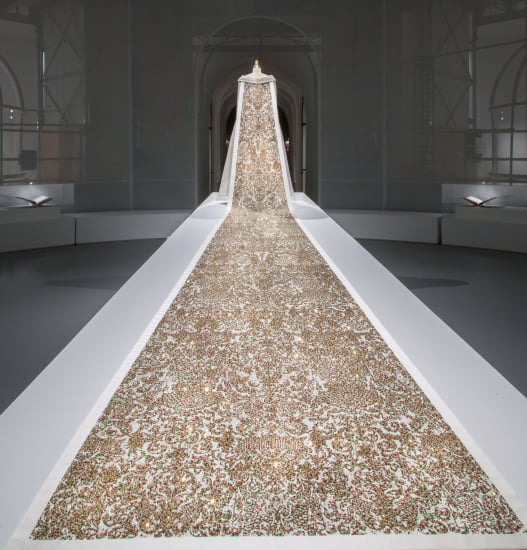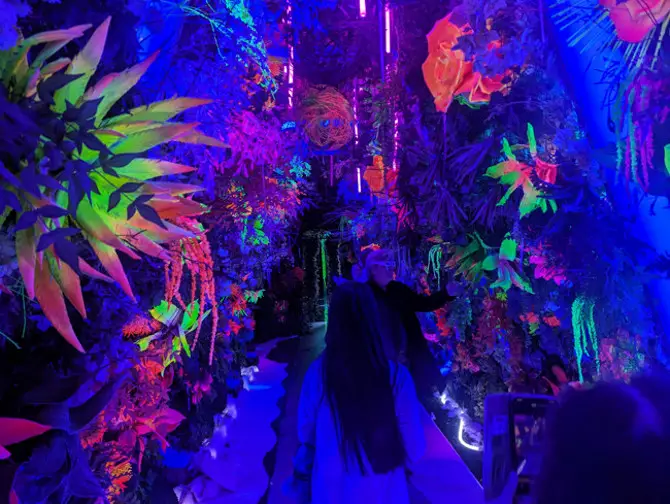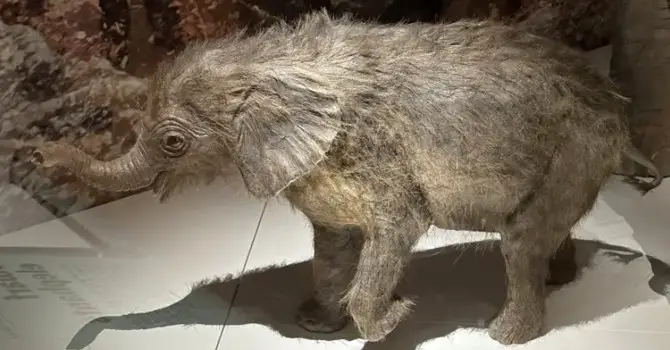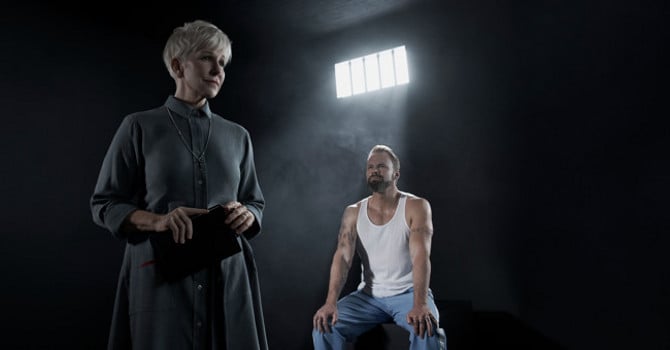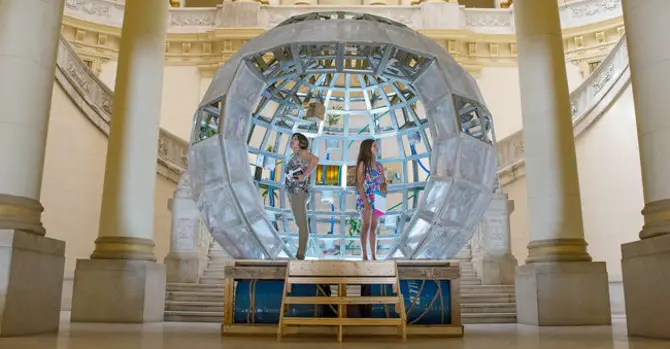As technology continues to advance, it impacts not only the world of gadgets and software, but also the more traditional arts. Its effect on the fashion realm is now being explored at The Metropolitan Museum of Art in Manus x Machina: Fashion in an Age of Technology, an exhibition that makes the case both for technology and the power of traditional methods.
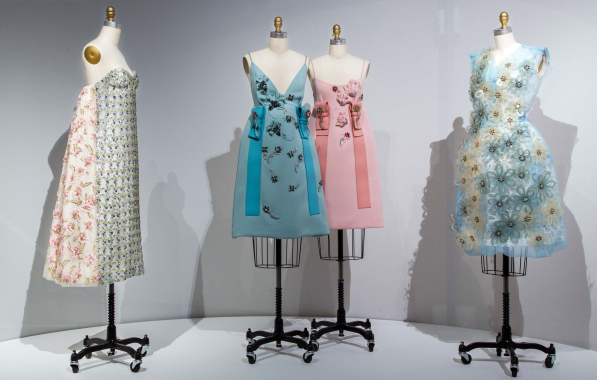
Upper Level Gallery View: Artificial Flowers © The Metropolitan Museum of Art
Manus x Machina explores the relationship between fashion’s two major categories: haute couture, custom-made garments crafted by hand, and prêt a porter, ready-to-wear clothing that’s machine-made and often intended for mass production. Though the two categories are usually thought to be distinct, Manus x Machina blurs the line, demonstrating the equality between hand and machine, how they can be used to create stunning fashions. Structured using the traditional métiers of the haute couture, the exhibition is organized around different fashion processes, including artificial flowers, leatherwork, featherwork, and pleating.
Upper Level Gallery View: Case Study, Wedding ensemble, Karl Lagerfeld for House of Chanel, autumn/winter 2014–15 haute couture, back view; Courtesy of CHANEL Patrimoine Collection © The Metropolitan Museum of Art
The centerpiece of the exhibition is Wedding Ensemble, by Karl Lagerfeld, for House of Chanel’s 2014-15 collection. It beautifully epitomizes this relationship between the hand and the machine. The stunning dress features a lengthy machine-sewn train with a baroque pattern that was first hand-sketched, then digitally manipulated and printed onto the garment, then finished through hand painting and embroidery. In total, the train alone required 450 hours of workmanship, and could not have been created without the hand and the machine working in tandem.
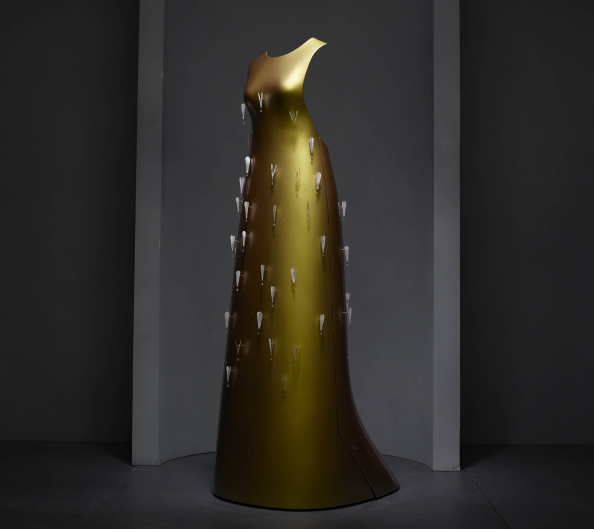
Hussein Chalayan’s “Kaikoku” Floating Dress © The Metropolitan Museum of Art
The allusion to technology in the exhibition’s title feels slightly misleading; though Apple sponsors the show, visitors shouldn’t expect to see a host of high-tech gadgetry on display—or even the futuristic-looking metallics worn by attendees at the Manus x Machina-themed Met Gala earlier this week. The exhibition instead takes a more subdued approach to its technological focus. There are exceptions: a number of outfits on display on the ground floor were created through 3D printing methods, while the artificial flower section includes Hussein Chalayan’s “Kaikoku” Floating Dress, a sleek, gold, remote-controlled dress covered in spring-loaded “pollens” that can be simultaneously released into the air and swirl around the wearer.
Largely, however, Manus x Machina explores technology as a tool that fashion designers employ to help them achieve their visions, as opposed to having the technology drive their aesthetic or functional decisions. Elements of the ensembles have been machine-sewn, 3D printed, laser cut, machine-embroidered, molded, and more. These processes, however, are revealed only through the supporting information; in the final garment, it’s the designer, not the technology, dictating each look.
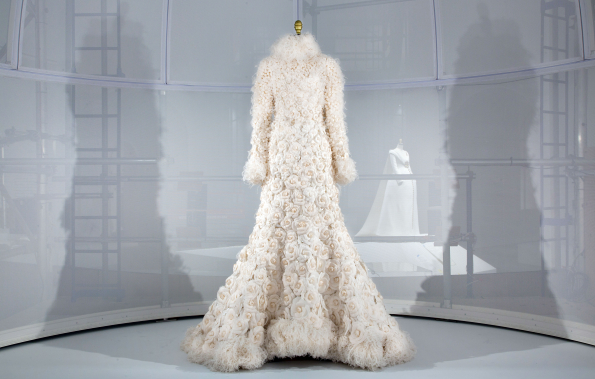
Upper Level Gallery View: Artificial Flowers Case Study, Wedding Ensemble, Karl Lagerfeld for House of Chanel, autumn/winter 2005–6 haute couture, back view; Courtesy of CHANEL Patrimoine Collection © The Metropolitan Museum of Art
True to the exhibition’s theme, Manus x Machina also includes plenty of stunning work created by hand, demonstrating the enduring power of hand-crafted fashion in this “age of technology.” In addition to the centerpiece dress, the exhibition also features an earlier wedding dress by Karl Lagerfeld for Chanel from 2005-06, which is covered in artificial flowers that take 90 minutes each to create by hand. Together with the embroidery and featherwork, the graceful ensemble required several hundred hours of handiwork.
The show’s varied collection blurs the distinctions between this haute couture method and machine-made prêt-a-porter garments, sometimes to the point of confusion as to where the division between the two actually lies. But it is clear how the two processes can exist as equals in the high fashion world. The combination of techniques on display in the pieces makes it obvious that having both options available to designers only enhances the quality of their work.
Andrew Bolton, Curator in Charge of The Costume Institute, explains:
“Instead of presenting the handmade and the machine-made as oppositional, [Manus x Machina] suggests a spectrum of practice, whereby the handmade and the machine-made are equal protagonists in solving design problems, enhancing design practices, and ultimately advancing the future of fashion. At the same time…the exhibition questions the symbolic meaning of the hand/machine dichotomy. Traditionally, the hand has been identified with exclusivity, spontaneity, and individuality, yet, ultimately, representative of elitism, the cult of personality, and a detrimental nostalgia for past craftsmanship. Likewise, the machine has been understood to signify not only progress, democracy, and mass production, but also inferiority, dehumanization, and homogenization. In examining these associations, our intention is to liberate the handmade and the machine-made from their usual confines of the haute couture and prêt a porter, and release them into the hands of fashion designers.”
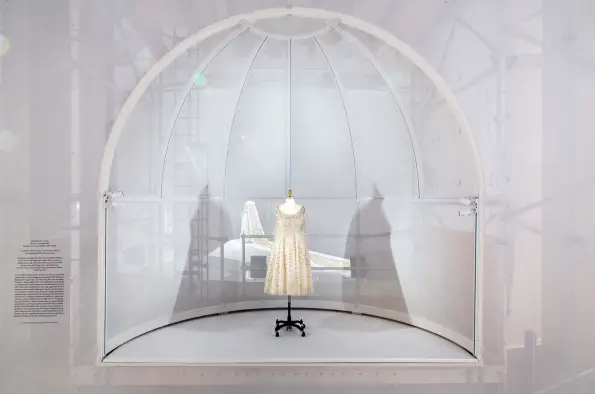
Upper Level Gallery View: Embroidery Case Study “L’Eléphant Blanc” Evening Dress, Yves Saint Laurent for House of Dior, spring/summer 1958, haute couture; The Metropolitan Museum of Art, Gift of Bernice Chrysler Garbisch, 1977 (1977.329.5a, b)
© The Metropolitan Museum of Art
Unlike the opulence of last year’s China: Through the Looking Glass, Manus x Machina’s exhibition design feels fairly stark, based around white scrims, faint projections, and barely obscured scaffolding. The only sense of grandeur comes from the domed ceiling and sleek minimalism of the center room housing Lagerfeld’s spectacular wedding dress and train. Like the garments on display, there’s little overt technology in the design, with the only gadgetry being small video projectors displaying several of the garments in action. The results feel focused on process, providing a streamlined, unassuming canvas for the designs themselves.
Manus x Machina dazzles visitors through its details, rather than upon first glance. The beautiful pieces on display, of course, are often visually astounding on their own, with eye-popping aesthetics and embellishments expertly crafted by fashion’s top minds. But by digging into the accompanying captions and discovering the extraordinarily intricate work that goes into each garment, it becomes obvious how truly spectacular this collection is.
Manus x Machina: Fashion in an Age of Technology is on view at the Metropolitan Museum of Art, now extended through September 5th, 2016. For more information, visit metmuseum.org.


